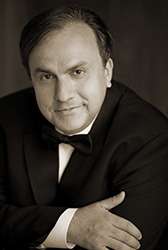|
Back
Glitter and Grandeur New York
Isaac Stern Auditorium, Carnegie Hall
03/23/2012 -
Franz Josef Haydn: Sonata in C Major, Hob. XVI:50
Johannes Brahms: Piano Sonata No. 3 in F Minor, Op. 5
Sergei Prokofiev: Sonata No. 8 in B-flat Major, Op. 84
Yefim Bronfman (Pianist) 
Y. Bronfman (© Courtesy of the artist)
The conundrum of a Yefim Bronfman recital is that the deepest most intense music frequently leaves less of an after-impression than the supposed “throwaway” works.
Last night, Mr. Bronfman’s three sonatas included a most mysterious late work by Sergei Prokofiev, an early but beautifully fashioned Brahms sonata, and a short Haydn sonata in the harmless key of C Major. Yet, while enjoying the longer pieces, the Haydn showed exactly why Mr. Bronfman is in the halcyon of great pianists today.
Why did Haydn’s clever trifle trump the more “interesting” later works? Perhaps because one knew Mr. Bronfman would play the Brahms and Prokofiev with such mental and digital strength, with such an unerring understanding of the Brahms melos and Prokofiev mysteries, that one could sit back and (blush!) actually enjoy the music without any fears.
But the Haydn? Many pianists toss it off as a trifle. Mr. Bronfman didn’t labor under the illusion that this was a work with dark underpinnings. Yet joy of sheer inspiration was sufficient enough–and difficult enough–to allow him to pass on that same enjoyment to us.
Like a great magician, he never let us in on the secret of the Haydn. The first movement was a series of short delicious statements tied together by invisible spidery lines. The second movement was played with an almost mock gravitas, as if Haydn realized it was necessary to add a wee bit of pathos to the delight of the piece, which had been written for a pianist friend.
And that friend might have laughed out loud–as some of us did (but quietly so as not to drown out the coughers in the audience)–hearing how Haydn, and then Bronfman led us through the carnival of the finale. He produced false endings, eccentric metrical changes, most unschlarly modulations. This was not Haydn of the oratorios, but Haydn the jeweler, showing us the sparkle, making the jewels disappear and come back again in another form.
At the end, Mr. Bronfman, neither pushing it nor showing us his virtuosity, had shown us a whole jewel box of Haydn treasures, each so enchanting that we didn’t even realize, until the last chord, what a magical show it had been.
The following Brahms was not a complete contrast, since the middle movements have the grace and elegance (if hardly the humor) of Haydn. Mr. Bronfman started with all the power at his command for the victorious opening. His powerful hands at each end of the keyboard soon let themselves into a more lyrical phase, followed by four more movements eqaually engaging. That scherzo was played with far more viciousness than usual, but Mr. Bronfman perhaps felt that contrast to be Brahms’s due as a young man (he was only 20 when he wrote it).
Nobody is more “pianistic” than Bronfman, but simultaneously, he had no hesitation in brining out some of the brassy low-string color which Brahms would soon use in his symphonies.
The final work was Prokofiev’s half-hour Eighth Sonata with its terrifyingly difficult finale (guaranteed to make audiences jump out of their seats with applause), though for an artist of Mr. Bronfman’s brilliance, a walk in the park (Albeit a park in the middle of a tornado.)
The first movement was more mysterious, though Mr. Bronfman chose to play the opening theme with a lyrical introspection and Chopinesque grace. Things obviously got stormier after that, but he gave an idyllic dreaminess to the second movement before plunging into the finale.
The two Chopin etudes were dazzling enough–under Mr. Bronfman’s hands, they are less “studies”, more Jackson Pollack canvases of whirls and gyrations. Yet after the concert, the Chopin, the Prokofiev war sonata and Brahms musculature were superseded by those iridescent Haydn precious gems.
Harry Rolnick
|